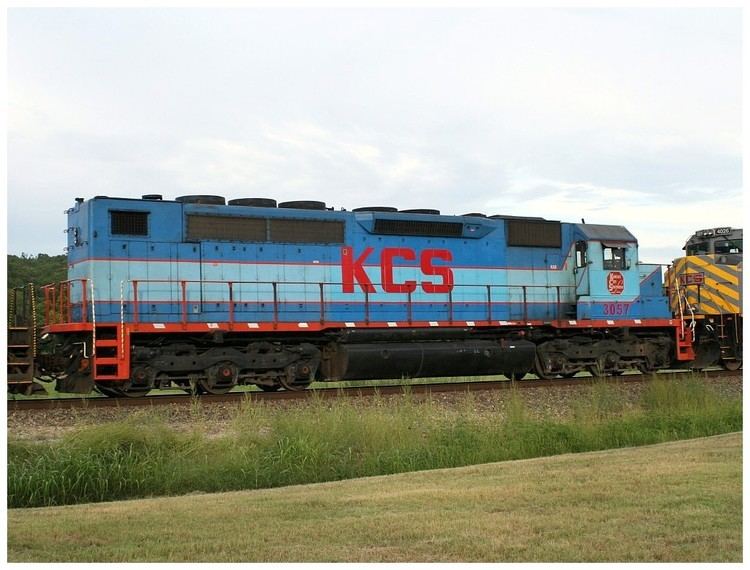Power type Diesel-electric Build date June 1966 – May 1970 AAR wheel arr. C-C | Model SDP40 Total produced 20 | |
 | ||
Builder General Motors Electro-Motive Division (EMD) | ||
An SDP40 is a 6-axle passenger diesel-electric locomotive built by General Motors Electro-Motive Division (EMD) between June 1966 and May 1970.
Contents
Design
Like its predecessor in EMD's catalog, the SDP35, the SDP40 is a high-horsepower freight locomotive with equipment for passenger train service.
In 1966, EMD replaced all their production units with those powered by the new 645 diesel. They included six-axle models SD38, SD40 and SD45, in addition to SDP40. All had standard components including the frame, cab, generator, trucks, traction motors, and air brakes. The main difference was the power: SD38 = 2,000 hp (1,490 kW) from a non-turbocharged V16, SD40 = 3,000 hp (2,240 kW) from a turbocharged V16, and SD45 = 3,600 hp (2,680 kW) from a turbocharged V20.
The SD40 and SDP40 were so similar that EMD published common operator's and service manuals to cover both.
At the time most passenger locomotives needed to provide steam to the passenger cars for heating, cooking, and sometimes cooling. They needed a higher gear ratio for faster running, the graduated-release feature on the air brakes, and type F tight-lock couplers to keep equipment together in the event of a derailment. To fit a steam generator to the freight-only SD40, the designers had to move the machinery forward about 2 feet (0.61 m) on the frame, add a compartment behind the radiators for the boiler, and divide the fuel tank into fuel and water sections.
Appearance
Earlier passenger diesels, like EMD E8, ALCO PA, FM Erie-built and Baldwin Sharknose locomotives, were streamlined cab units designed for visual appeal and the appearance of speed. The SDP40 instead has the rugged appeal of a high-horsepower road-switcher locomotives of the time. This look was contemporary to, and eventually overtaken by cowl units like the GE U30CG and EMD FP45, SDP40F and F40PH.
Visually, the locomotive is a hood unit distinguished only by the shape of its rear end behind the radiators, with its flat end having no number boards, shuttered boiler air intake on each side, extra exhaust stacks over the boiler, cantilevered walkway around the flat end, and very steep rear steps. EMD applied this same end to the passenger SDP35, SDP45, and GP40P locomotives, as well as the freight DD35, DDA40X and SD40T-2.
Amtrak's SDP40F locomotive, although sharing several mechanical specifications, is visually a much different locomotive. Seven years separate their introductions, and the SDP40F was actually based on the SD40-2. It had a full-width carbody, similar to the FP45. It was also 6 feet (1.83 m) longer than the SDP40.
Original Owners
Great Northern Railway (GN) purchased the first six SDP40s in 1966, to replace older F-units on their Western Star and smaller regional trains. Options included Vapor OK-4740 steam generators, water-transfer capability between units, 59:18 gearing for a top speed of 83 mph (134 km/h), and Type-F couplers. These were followed in 1967 by eight more powerful SDP45 locomotives ordered for the Empire Builder. After the startup of Amtrak in 1971, Great Northern's successor Burlington Northern Railroad (BN) converted the locomotives to freight service.
One SDP40, former GN 323, was temporarily renumbered BN 1976 and painted in red, white and blue for the United States Bicentennial in 1976.
NdeM had ten units delivered in 1968 and another four in 1970. In 1998, the government of Mexico privatized the NdeM the locomotives were split between two successor companies. Eight went to TFM, which was later purchased by Kansas City Southern Railway and became KCSM. Of those eight, two were rebuilt to SD22ECOs, and the other six were scrapped. The remaining six went to Ferromex. Of those six, four were rebuilt to SDP40-2s and remain in service, the other two were scrapped.
Wrecks
On August 23, 1979, BN 6399 was the lead unit of train 23 when it ran head-on into train 182 at Maiden Rock, WI. 6399 was repaired and returned to service, as were the four units of the other train. The three trailing GP40 units were destroyed.
Rebuilds
A consideration when rebuilding an SDP40 is that the rear corner steps do not comply with current Federal Regulations. The bottom step must be further out than the upper steps to provide a place to stand. Since the steam generator compartment extends to the end of the frame, it must be removed to install compliant switching steps. FXE 3212 and GCFX 3093 are examples. See:
The KCS pair rebuilt into SD22ECOs took a different approach: The bottom steps of the rear ladders were moved out to meet the requirement.
Preservation
BNSF Railway donated #6327 - former GN 325 and their last SDP40 in service - to the Minnesota Transportation Museum in May 2009. Since then, it has been in service on the Osceola and St. Croix Valley Railway. The Museum has renumbered the locomotive back to 325 and ,in the future, it will be repainted in the Great Northern "Big Sky Blue" paint scheme.
